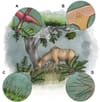Redlands News: April 18, 2025
$872K police settlement, Measure D school upgrades, Easter Bunny events, and The Great Y Circus returns May 2
New research from Loma Linda University reveals toxic traits in plants, fungi, and even viruses

LOMA LINDA, Calif. — Venom may be far more common in nature than previously thought — and not just in animals.
Why it matters: A newly published study from Loma Linda University School of Medicine finds that plants, fungi, protists, bacteria, and some viruses have evolved venom-like mechanisms used for survival, defense, or competition — a discovery that could open doors for future medical research and innovation.
“That’s only a tiny fraction of organisms we could study for meaningful tools and cures,” said lead author William K. Hayes, Ph.D., professor of biology at LLU.
What’s new: The study, titled It’s a Small World After All, redefines venom as a biological toxin introduced into another organism through a wound — not necessarily through an animal bite or sting.
Researchers found:
The backstory: Hayes, a longtime rattlesnake venom researcher, began broadening his definition of venom over a decade ago. What started as a side discussion in class turned into a full research project as his team uncovered overlooked examples of venom across multiple kingdoms of life.
“We’ve only scratched the surface in understanding the evolutionary pathways of venom divergence, which include gene duplication, co-option of existing genes, and natural selection,” said Hayes.
What's next: Hayes hopes this new definition of venom will encourage cross-disciplinary collaboration — and eventually lead to new life-saving treatments.
The full study is titled It’s a Small World After All: The Remarkable but Overlooked Diversity of Venomous Organisms, with Candidates Among Plants, Fungi, Protists, Bacteria, and Viruses.
Sign up for our weekly newsletter